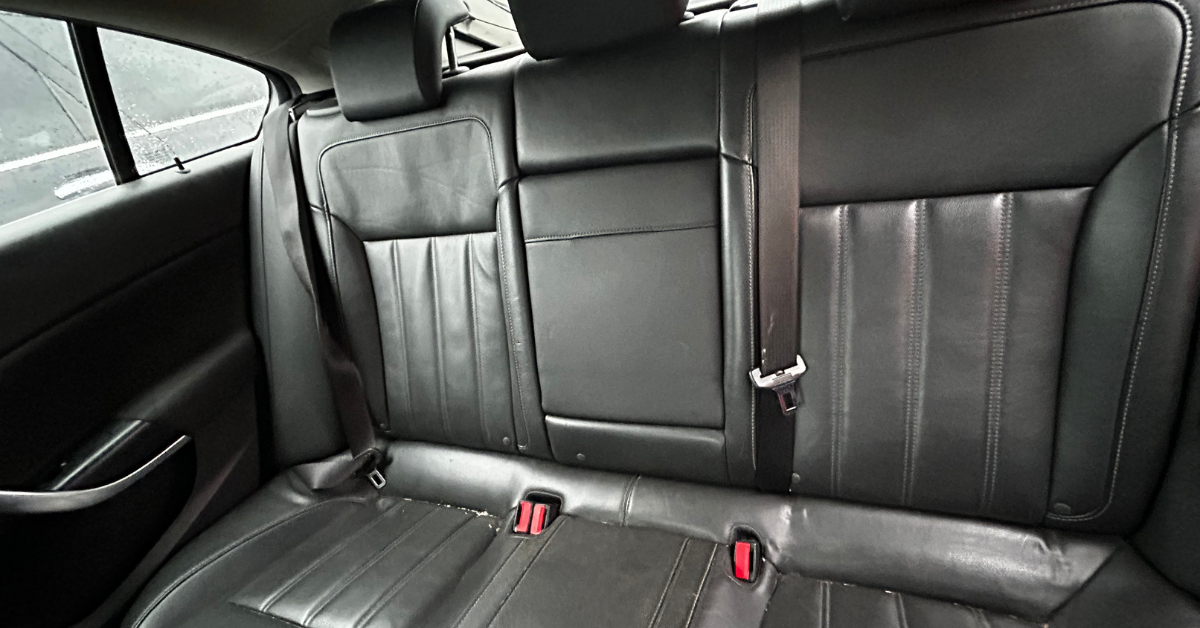Seatbelts have come a long way from the simple lap strap first introduced in the 1960s.
Today’s restraints are engineered with hidden mechanisms, load limiters, pre-tensioners, and rapid-response sensors that work together to reduce injury in a matter of milliseconds.
In honour of National Seatbelt Day, our guide explores the modern science behind seatbelts, the real-world risks that can occur when things go wrong, and how these factors influence crash outcomes, insurance write-offs, and the number of vehicles we see scrapped across the UK each year.

We’ve all felt that moment when you move a little too quickly, reach forward, and the seatbelt suddenly locks.
It’s frustrating when you’re just grabbing your phone as a passenger or adjusting the mirror, but vital in the split second where it matters. That locking motion is exactly how your belt protects you.
Modern belts contain pre-tensioners that instantly tighten during a collision, pulling you back into position. Load limiters then release a controlled amount of webbing to reduce chest force.
These mechanisms work in coordination with airbags, allowing both systems to deploy at the correct time and distance from the occupant.
Even small delays can dramatically change injury severity, which is why modern restraint systems are designed to react quickly.
Despite decades of safety awareness, UK drivers still commonly misuse seatbelts. Wearing a belt under the arm, behind the back, or too loosely disrupts how the restraint reacts in a crash.
Twisted belts can’t distribute force evenly, and worn anchor points compromise the entire system.
Recent statistics highlight how serious the problem remains.
Even when belts are correctly fastened, rear-seat passengers evidently underestimate their importance.
Misuse increases injury risk for everyone in the car, not just the person not wearing the seatbelt.
Failing to wear a belt can also lead to an on-the-spot £100 fine, which may increase to £500 if taken to court.
This reflects the severe dangers caused by not being properly restrained.
Everyone hears the usual warnings about the risks of not wearing a seatbelt, but the reality extends far beyond the unbelted person.
So every time you get into a car, wear your seatbelt. You will avoid unnecessary fines, reduce your own risk of serious injury, and protect the people around you from preventable harm.
Seatbelt failure is rare, but misuse, old components, previous crash damage, or worn parts can reduce effectiveness.
A belt that has already deployed its internal mechanisms should never be reused, and many components are single-use.
Insurers often write off vehicles where pre-tensioners have fired or where multiple belt and sensor replacements are required.
The cost of restoring the full restraint system, combined with airbag replacements, can exceed the value of the vehicle.
If your car has been written off due to restraint or airbag damage, Scrap Local offers free collection, guaranteed prices, and a stress-free scrappage process.
Today’s vehicles come equipped with advanced restraint systems designed to protect a wide range of occupants:
Each of these features enhances safety, but also makes repairs more expensive when components need replacing.
Restraint system damage is one of the biggest contributors to write-off classifications. Even if the exterior damage seems minor, deployed or damaged belts and airbags require expensive repairs. For many vehicles, this leads to an expensive repair decision.
If you’re repairing an accident-damaged vehicle and need affordable replacement parts, Parts Local connects you with trusted used components across the UK.
A few basic checks can improve your safety:
For more information on crash damage or write-off decisions, explore our guides on insurance write-off categories and vehicle safety.
As cars become more advanced, restraint systems continue to evolve.
Understanding how they work helps drivers stay informed, safer, and more aware of how crash forces affect both occupants and the long-term condition of the vehicle.
Scrap Local remains committed to supporting drivers across the UK, whether you’re looking to scrap a damaged vehicle, understand write-off decisions, or source quality used parts.
Common questions and answers about seatbelts, crash risks and UK legal requirements.
For all of our FAQs, visit Scrap Local’s FAQ page.
Seatbelts that have locked, deployed pre-tensioners, stretched, or show signs of force should always be replaced.
These components are usually single-use and may fail to protect you properly in another collision.
Seatbelts and airbags form a coordinated system. Pre-tensioners tighten the belt first, positioning the occupant correctly.
Airbags then inflate to cushion the impact. Without the seatbelt holding you in place, airbags can’t protect you effectively.
Yes. MOT testers check belt condition, retraction, locking, and anchor points. Any damage, excessive wear, or malfunction will result in a failure until corrected.
Yes. UK law requires seatbelts to be worn correctly. Wearing a belt under the arm or behind the back increases injury risk and can lead to fines and penalty points.
A failed sensor can trigger dashboard warnings and may disable parts of the restraint system. In many cases, repairs are required before the vehicle is considered safe or roadworthy.
Choose a service & we’ll search our network to find you the best scrapyard for your enquiry!
We have hundreds of scrap car buyers waiting to buy your scrap car.